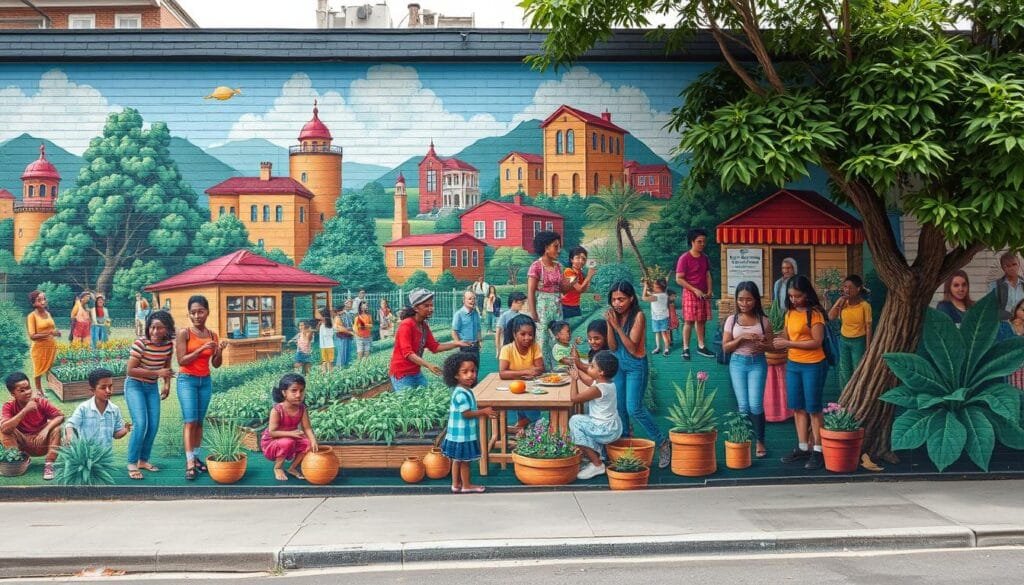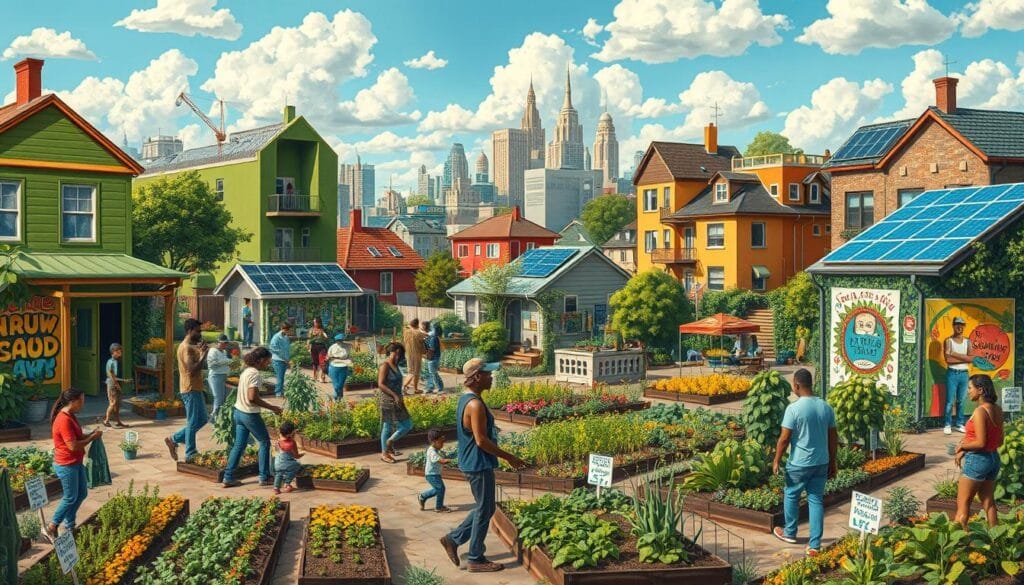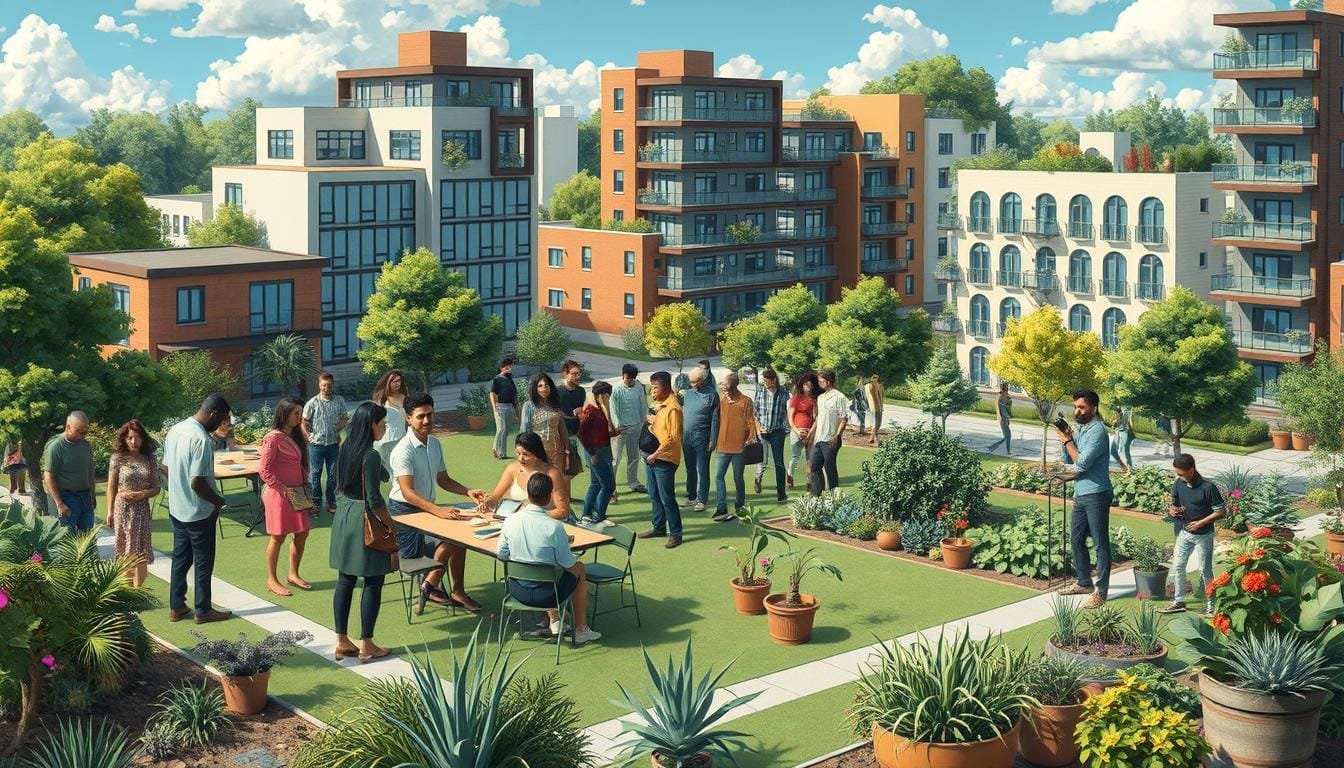People have long debated the effects of socialism on society. This article will look at socialism from different angles, including economic, social, and political views. We will compare it to other economic systems like democratic capitalism and communism.
Socialism aims to provide equal opportunities for everyone, but not everyone agrees it works well. Countries like the Soviet Union and China have tried a centralized socialist approach, leading to big changes. Meanwhile, Scandinavian countries like Sweden and Norway mix socialism with democracy. They offer free healthcare and education, improving people’s lives.
Exploring socialism’s history is crucial to understanding its impact. We will look into its beginning in Plato’s “Republic” and how it’s used today in social democracy and market socialism. This will help us see the good and bad sides of socialism on society.
Key Takeaways
- The effects of socialism on society are multifaceted, influencing economic management and individual freedoms.
- Scandinavian countries effectively combine socialism with democracy, ensuring high living standards.
- Centralized socialist models, such as those in the Soviet Union and China, have had profound social and political impacts.
- Socialism’s principles guide ongoing discussions on fairness, justice, and resource distribution globally.
- A thorough socialism analysis reveals both strengths and weaknesses, informing future societal and economic structures.
By looking at historical examples, case studies, and modern ways of using socialism, we can understand its effect on society better. This includes its role in today’s economic debates. Check out the comprehensive impact of socialism on society for more insight.
Introduction to Socialism and Its Core Principles
The definition of socialism introduces a system where the community or state mostly controls production. It’s different from capitalism, which focuses on private control and open markets. Learning about socialism’s history shows how these ideas have changed to fix unfairness from capitalism and industrial growth.
Defining Socialism
Socialism means the community owns production tools. This could be through state control or by workers themselves. It’s unlike capitalism, which lets market forces decide everything. Socialism wants fair share and use of resources to meet everyone’s needs, not just to make private profit. It looks to lessen the gap between rich and poor.
The Roots of Socialism
The history of socialism starts with early visionaries like Robert Owen and Henri de Saint-Simon. They dreamed of societies built on cooperation. Socialism really grew during the industrial revolution through the critiques of Karl Marx and Vladimir Lenin. They highlighted capitalism’s flaws. Since then, socialism has split into different types, each finding ways to work today. Countries like China, Cuba, and Vietnam explore socialism in their own way.
Core Ideals and Objectives
Socialism aims to cut down economic difference and push for community-owned production. Its main goals are fair wealth distribution, destroying class systems, and making sure work benefits everyone. New versions, like market socialism, mix in some market ideas while keeping to socialism’s goal of community gain. This mix tries to keep socialism’s main aim while dealing with today’s global economy.
“The history of all hitherto existing society is the history of class struggles.” – Karl Marx
Exploring socialist thought shows its call for a just, fair society. The principles of socialism still prompt discussions and actions for fairness in our world today.
Historical Context: Evolution of Socialist Movements
Socialist movements have deep roots that go back to ancient Greece. We must look at key historical milestones to grasp their growth. This journey helps us appreciate the varied thinkers who shaped socialist thoughts and the economic conditions that fueled these ideas.
Early Roots in Plato’s “Republic”
Plato’s Republic talks about an ideal state with fairness for all. Here, leaders would manage resources for the common good and ensure wealth is shared. Even though it’s not socialist by today’s standards, it set the stage for social equality that influences socialism now.
Industrial Revolution and Emergence of Modern Socialism
The Industrial Revolution was a turning point that pushed modern socialism forward. It highlighted the harsh realities of labor exploitation and social inequality. Thinkers like Karl Marx and Friedrich Engels offered a new perspective with the Communist Manifesto, advocating for worker rights and the end of class divisions.
Major Socialist Thinkers and Their Contributions
Many thinkers have shaped socialist ideals beyond Marx and Engels. Early figures like Robert Owen and Charles Fourier aimed for communities based on socialism. Lenin’s work led to the Soviet Union’s creation, a landmark in socialist history.
In the 20th century, socialist parties like the Labour Party in the UK gained momentum. By the mid-20th century, Europe saw social democracies strive for change within capitalism. They sought social security, healthcare, and workers’ rights.
Recent decades have seen socialism shape global policies. Leaders like Hugo Chávez in Venezuela have leaned into socialism, emphasizing public welfare. This shows socialism’s lasting influence worldwide, even in non-socialist governments, aiming to lessen social disparities.
| Thinker | Contribution |
|---|---|
| Plato | Conceptual framework for a just state |
| Karl Marx & Friedrich Engels | Development of scientific socialism |
| Robert Owen | Utopian socialism and labor reform |
| Vladimir Lenin | Implementation of Marxist principles in the Soviet Union |
| Hugo Chávez | 21st-century socialism and populist policies |
What Impact Did Socialism Have on Society?
Socialism has changed society in many ways, touching on economy, social norms, and politics. Let’s look at these changes closely.

Economic Outcomes
Socialism aims to lessen wealth differences, joblessness, and price rises with various strategies. One method is controlling prices through the state managing key sectors. This helps to set product amounts and prices while also funding important research.
Other efforts include making the rich pay more taxes and providing help to those in need. This helps reduce the gap between rich and poor. There are also laws to ensure fair pay and good job conditions, backed by the right to join worker unions.
Social Changes
Socialism strives for equality, trying to remove class differences. When the government takes over certain businesses, workers might get more control. This can lead to better work conditions and stronger communities.
Free public services like schools, hospitals, and housing highlight socialism’s focus on collective good. Social democracies tax the wealthy more to balance society’s wealth. This shows how deeply socialism cares about fair development for everyone.
Political Shifts
Socialist ideas have influenced governments worldwide. Great thinkers like Karl Marx laid socialism’s foundations, arguing for community over individual property rights. In the 1900s, socialists started to gain political ground.
In 1912, Eugene V. Debs won six percent of the vote, and in 2016, Bernie Sanders got 45 percent in the Democratic primary. These examples show socialism’s varied political journey, which includes both global and national perspectives.
Comparing Socialism with Capitalism and Communism
We need to compare socialism to capitalism and communism to really get its unique points. These ideas differ greatly in how they handle ownership, spreading out wealth, and their economic systems.

Differences and Similarities
When we look at socialism versus capitalism, ownership is a big difference. Capitalism promotes private ownership, meaning people own factories and businesses. On the other hand, socialism pushes for everyone to own things together and wants wealth to be spread out more fairly.
Looking at socialism and communism, they both want to fix wealth gaps. But, communism wants to get rid of personal ownership totally, aiming for a society without social classes. They both started to fight against how the working class was treated unfairly during the Industrial Revolution.
Strengths and Weaknesses
Socialism’s big plus is its focus on equality and taking care of everyone. It tries to make sure all people have what they need, like the Social Security system does in the US. Capitalism’s strength is in letting free competition drive prices with supply and demand. This encourages new ideas and efficiency.
But, socialism can lead to economic problems and too much government control. Capitalism, meanwhile, can cause big gaps in income and take advantage of people. Communism aims for complete equality but often struggles to keep its economy strong. It has also led to dictatorships in the past.
Case Studies of Socialist Countries
Looking at socialist countries helps us see socialism in action. The USSR and China show us different outcomes. The USSR’s strong socialist policies ended in economic trouble and its collapse. China mixed socialism with capitalism, which led to fast economic growth. However, it still deals with wealth inequality issues.
In Scandinavia, social democratic policies have led to high living standards and very little poverty. These countries find a middle ground between socialism and capitalism. This shows the benefits of blending parts of both systems together.
Studying socialist countries also shows how socialism can change and fit different economic setups. From strict regulations to mixed economies that blend socialist and capitalist features, there’s a wide range of approaches.
Modern Applications of Socialism in Today’s World
The way we see socialism today has changed a lot. It now fits into the world economy and new ideas. We have things like social democracy and market socialism. They show how we use socialist ideas now. They tell us how socialism can change societies today.
Social Democracy and Its Influence
Social democracy mixes socialism with capitalism. It tries to make both the economy work well and people’s lives better. It likes rules for the economy that let people be free but also take care of them. In places like Germany, it’s becoming popular. It supports protecting workers, the public owning important businesses, and sharing money fairly.
Leaders like Michelle Bachelet in Chile and Luiz Inácio Lula da Silva in Brazil support this. They work on cutting down inequality and promoting fairness.
Market Socialism
Market socialism blends the market with shared ownership. It’s a new kind of socialism. In this model, businesses are competitive, but everyone shares the profits. This setup is seen in Nordic countries. They have a lot of public ownership but still compete in the market.
Leaders like Hugo Chávez and Rafael Correa pushed for market socialism. They wanted to mix free markets with social fairness.
Central and Participatory Planning
Central and participatory planning try to make economy decisions more democratic. Central planning means the state decides what and how to produce and distribute. The Soviet Union used to do this. Participatory planning means communities and grassroots movements get a say. It learns from old traditions and earlier socialist efforts in Latin America.
These methods aim to make sure plans meet what people need and want. This way, the market doesn’t control everything.

| Country | Model | Key Features | Notable Leaders |
|---|---|---|---|
| Germany | Social Democracy | Public ownership, social welfare | Michelle Bachelet |
| Nordic Countries | Market Socialism | High public ownership, competitive market | Fred Trump (Historical example) |
| Venezuela | Participatory Planning | Community decision-making | Hugo Chávez |
| Brazil | Social Democracy | Equitable income distribution, worker protections | Luiz Inácio Lula da Silva |
Conclusion
As we wrap up our deep dive into socialism, we see its huge impact on the world. This idea has changed how people view money, power, and working together. Socialism pushes for everyone to have an equal share and a say in big decisions.
By looking at thinkers like Karl Marx and Friedrich Engels, we learn how they sparked big changes. They inspired movements and showed us different ways socialism can work today. Our source material talks about these changes and how we can keep adapting.
Looking ahead, socialism must keep evolving to keep up with our changing world. Being flexible helps tackle new problems and grab new chances. This journey shows us how important peoples’ roles and choices are in shaping our communities. It invites us to think deeply about our values and how we live together.
FAQ
What is socialism?
Socialism is an economic and political system. It is known for collective ownership and focuses on sharing resources fairly. This approach aims for community benefit, unlike capitalism, which values private ownership.
What are the core principles of socialism?
Socialism’s core principles include fair sharing, removing class divisions, and focusing on community needs. These ideas help reduce wealth differences and increase everyone’s well-being.
How did socialism originate?
Socialism’s ideas go way back to ancient times but got formal recognition during the Industrial Revolution. Influences came from Plato’s “Republic” and thinkers like Karl Marx, Lenin, and Robert Owen.
What major changes did socialism bring to society?
Socialism shaped society in several ways, improving economy, social, and political fields. It aims for economic fairness and has led to strong welfare support. Socially, it tries to end class difference and build a united community.
Politically, it can vary, mixing state control with either democracy or authority.
How does socialism differ from capitalism and communism?
Socialism and capitalism differ in ownership; socialism prefers shared control, while capitalism likes private. Compared to communism, socialism is more moderate. Communism seeks a society without classes or state. Socialism balances social welfare and government in its approach.
What are the strengths and weaknesses of socialism?
Socialism’s strengths lie in its push for equality and covering basic needs, which lowers poverty and inequality. But, it is often critiqued for economic inefficiency, stifling innovation, and too much government control.
Can you provide examples of socialist countries and their outcomes?
The USSR and China are key examples. The USSR made vast industrial and scientific strides but faced economic and political challenges. China has merged socialism with market strategies, achieving economic growth but also dealing with social inequality and government domination.
How has socialism adapted in modern contexts?
Socialism has evolved, responding to economic and ideological changes. It now includes social democracy and market socialism. Social democracy mixes socialism’s welfare goals with capitalism’s economic system. Market socialism combines market operations with social ownership, exploring different planning methods.
